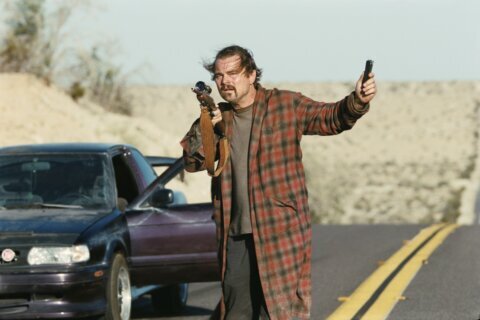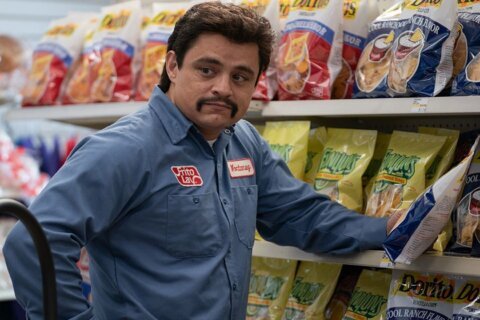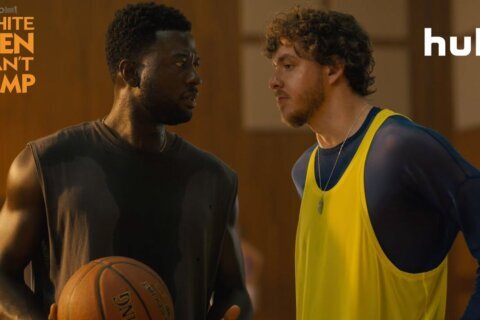Jason Fraley, WTOP film critic
WASHINGTON – Call it the scariest horror flick ever made, a “Moby Dick” action adventure, a social commentary on beach towns and greedy mayors or a humanistic story of family, science and wonder.
What better way to conclude WTOP Shark Week than with a “behind the scenes” look at the source of our fascination, the best-selling novel that became the “original” summer blockbuster, winner of three Oscars (editing, sound, score) and a classic that still has the chops to chill us decades later?
Hell on water
“When I first hear the word ‘Jaws,’ I think of a period in my life when I was much younger than I am now,” director Steven Spielberg says in the documentary “Spotlight on Location: The Making of Jaws.” “Because I was younger, I was more courageous, or I was more stupid, I’m not sure which. So when I think of ‘Jaws,’ I think about courage and stupidity, and I think of both of those things existing underwater.”
Spielberg was relatively unknown at the time, having directed the TV movie “Duel” (1971) about a killer tractor-trailer, and one big-screen feature, “The Sugarland Express” (1974), starring Goldie Hawn. When production on “Jaws” ran over schedule by four times the planned amount, the 20-something Spielberg was almost fired, but producer Richard D. Zanuck fought for him to remain on the picture. Just think of all the great movies we would have missed if Spielberg had been labeled a failure.
The reason for the delay was that the film’s star had stage fright. The mechanical shark, nicknamed “Bruce,” did not react well to the waters off Martha’s Vineyard, and it did not work most of the time. While this created headaches for production, it was a blessing in disguise, forcing Spielberg to find creative ways of depicting the shark, like pulling a fishing pier or a series of harpooned yellow barrels.
![]()
Less is more
The result was a series of terrifying POV shots set to John Williams’ Oscar- winning, two-note score, which Spielberg credited for half the film’s success. It ranked No. 6 on AFI’s Top 25 Movie Scores, and can be hummed even by those who have never seen the film.
Let this be a lesson for today’s gore-obsessed filmmakers that less is more. Not only did the film limit the special effects appearances of the shark, which are bound to date over time, but it cemented the notion that the “unseen” is almost always scarier than the seen (i.e. Robert Wise’s “The Haunting”). In an era where audiences are desensitized to violence, the biggest terror is that which screws with our imagination. Spielberg knew this well in the film’s shocking opening scene, voted Bravo’s No. 1 Scariest Movie Moment.
“The book does describe the shark before you see the attack. I thought what could really be scary was not seeing the shark and just seeing the water,” Spielberg says. “We’re all familiar with the water. Very few of us have been in the water with a shark, but we’ve all gone swimming. And the idea of this girl going swimming and the audience going swimming with her would have been too extraordinary if, like a Leviathan, the shark had come out of the water with its jaws agape and come down on her, and it would have been a spectacular opening for the film, but there would have been nothing primal about it. It would have just been a monster moment that we’ve all seen.
“I really wanted to do it without seeing the shark in that case, and I wanted the violent jerking motions to just start to trigger our imaginations into either thinking about what was happening below the surface or blocking what was going on below the surface.”
![]()
A director is born
That’s Spielberg himself yanking the girl underwater, tugging on a special harness for the initial shark bite. His “touch” is apparent in instances throughout the film, perhaps his best directorial effort, save for his two Best Director Oscar wins for “Schindler’s List” (1993) and “Saving Private Ryan” (1998). For example:
- The reflection of book pages flipping in Brody’s glasses, and the reflection of the shark barrels in a window of the Orca.
- The gorgeous composition of Quint standing on the front of the boat.
- The combination of underwater and above-water shots, using a special camera apparatus to hover on the waterline.
- The illusion of a single take (i.e. Hitchcock’s “Rope”) during the attack on the Kinder boy, using bathers to “wipe” the screen to hide each cut, then using Hitchcock’s “Vertigo Effect” of a simultaneous dolly and zoom as Brody witnesses his first attack.
![]()
Casting your actor net
Perhaps Spielberg’s greatest touch is his flexible, open-minded directing of actors, allowing Roy Scheider to improvise with his on-screen son, mimicking each other’s hand motions for a tender moment until the tension is broken by Hooper’s knock at the door.
Spielberg had loved Scheider in “The French Connection” (1971), so when the two met at a party, he knew he had found Amity Police Chief Brody.
He also had loved Richard Dreyfus in “American Graffiti” (1973) and asked him to play the biologist Hooper. Dreyfus wasn’t thrilled about the role and came aboard kicking and screaming. The role inspired his casting as the lead in Spielberg’s “Close Encounters of the Third Kind” (1977).
Murray Hamilton (“The Graduate”) was always the first choice to play Amity’s scumbag mayor, and Spielberg cast Lorraine Gary as Brody’s wife Ellen because he liked her work on television.
As for the role of Quint, Spielberg originally wanted Lee Marvin (“Point Blank”) or Sterling Hayden (“The Godfather”), but producers Dick Zanuck and David Brown suggested Robert Shaw, who had just wowed audiences in “The Sting” (1973). Shaw’s drunken chemistry with Scheider and Dreyfus is priceless as they swap stories, compare scars and sing “Show Me the Way to Go Home.”
![]()
From novel to screen
The entire notion of the film was a simple yet novel idea. Why had no one tapped the dark depths and primal fears of the water before? Sometimes the best ideas are right under our noses. Peter Benchley captured a universal terror in his 1974 best-seller, starting a trend of Spielberg adapting novels into hits, from Michael Crichton’s “Jurassic Park” to Thomas Keneally’s “Schindler’s List.”
Benchley wrote the first draft of the script, Spielberg wrote the second, then Carl Gottlieb (“The Jerk”) wrote the final version. Ironically, the film’s most famous line was not even in the script. Roy Scheider improvised, “You’re gonna need a bigger boat,” and it became a pop culture phenomenon, voted No. 35 on the AFI’s Top 100 Movie Quotes.
Spielberg’s favorite scene remains the U.S.S. Indianapolis speech, written three times, first by screenwriter Howard Sackler (“The Great White Hope”), expanded into a lengthy speech by John Milius (“Magnum Force,” “Apocalypse Now”), then rewritten by Robert Shaw for his own taste.
Quint originally was supposed to die “Moby Dick”-style, tangled in a harpoon and dragged underwater. Instead, Spielberg insisted on going out with a bang. After Quint loses a knife battle with the shark, Chief Brody chucks a compressed-air canister into the shark’s mouth and shoots, exploding the shark into itty-bitty fish bait. Colleagues warned that this ending might feel unrealistic, but Spielberg said that if he had the audience in his palm for two hours, he could afford to go big.
![]()
Movie theater memories
I had the privilege of seeing this recently at the AFI Silver Theater in Silver Spring, and let me tell you, today’s youngsters roared at the exploding finale. It proved “Jaws” makes a killer movie theater experience all these years later.
I fondly recall stories of my mother seeing the film upon its release as a little girl, describing a hotshot man in a suit jumping over the seat into the row in front of him when the shark came out of the water.
Folks shared similar memories with me last week along Wisconsin Avenue in Northwest:
- Diane from D.C.: “I think of seeing the movie in the theater when I was a little girl living in Fort Lauderdale (Florida), going to the beach and being afraid of going in the ocean for many years after that.”
- Chris from D.C.: “What I notice is a lot of people use the phrase, ‘We’re gonna need a bigger boat,’ which I think is from that movie. I think a lot of people here in D.C, like politicians, talk about what we’re doing isn’t big enough, we need to do something more drastic, more impressive. So I think that’s one of the things that sticks with me from the movie.”
- Veronica from D.C: “I’ll tell you what really made people go, ‘Ahhh.’ [It was] ‘doo doo doo doo.’ The music!”
- Justin from Colorado: “When we were kids, in our [public] swimming pool, they would do a ‘Jaws’ night. So, you’d go out in the pool on your tube, they’d play the movie and they’d always have some lifeguard that would wear a ‘Jaws’ outfit and scare the fifth-graders.”
- Nikel from Connecticut: “For me, it’s the Universal Studios ride. No matter how many times I did that, I always thought it was going to eat me.”
- Phil from Vienna: “I remember him throwing that canister in the shark’s mouth and then shooting it … That was a good way to end it.”
If you add up all these movie memories, you’ll get the first movie in history to gross $100 million, achieving in just 80 days what it took “Star Wars” six months to accomplish.
The modern summer blockbuster was born, Spielberg’s career had been launched and a worldwide phobia had set in for beachgoers everywhere: “Don’t go into the water.”
★ ★ ★ ★
The above rating is based on a 4-star scale. Read more from WTOP Film Critic Jason Fraley by clicking “Fraley on Film” under the “Living” tab above, following @JasonFraleyWTOP on Twitter, and checking out his blog, The Film Spectrum.
(Copyright 2012 by WTOP. All Rights Reserved.)








